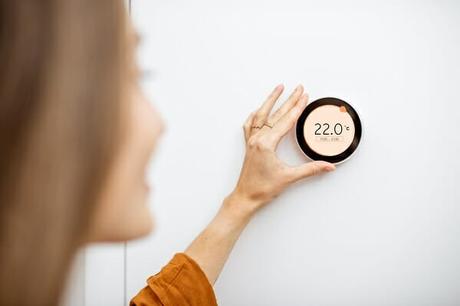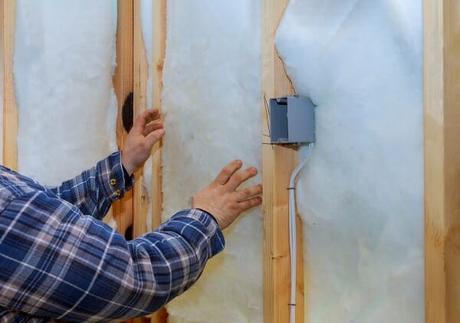Although we’ve covered this question before, we wanted a fresh take on whether leaving your heating on all day is good or bad, so here it is!
Most people love a warm house, especially in the cold winter months. What they don’t love is spending a fortune on their energy bills.
It’s why, time and again, people ask the question: “is it cheaper to keep your central heating on low all the time or programme it to come on and off at certain times in the day?”
It’s a hotly debated topic and, unfortunately, one without a straightforward answer. The truth is it might be cheaper to keep your central heating on low all the time, it all depends on a number of factors.
We’ll cover all those factors – and more – below.

Keeping Your Central Heating On Low vs Turning It On & Off
According to the experts at the Energy Savings Trust, the idea that you can save money by keeping your central heating permanently on low is a myth.
This is mainly because of problems with home insulation. If your house is old or draughty, for example, heat will be leaking out through windows and doors.
While leaving your heating on all the time will mean your boiler is constantly using energy to keep the temperature at a set level, with poor insulation it will have to work even harder to maintain this temperature.
An inefficient boiler, which already uses a lot of energy to run, is only going to add to the problem.
Despite the above facts, some engineers still maintain that keeping your boiler on low all the time can save you money – in the short term at least.
This is because turning your boiler on and off regularly will mean your boiler will need to use more energy to heat your home from cold to the desired temperature.
Is Your Home Well Insulated?

This is the first and most important question to ask yourself. If you live in a property with a high standard of insulation and the answer is “yes”, experts suggest you may be better off leaving the heating on at a set temperature.
Since a good level of insulation will prevent too much heat loss occurring, the thermostat will work with the boiler to maintain the temperature with relative ease.
If your house is damp, or you are going away on holiday, it may also be advisable to keep your heating on low, even if it is the more expensive option.
This can protect your house against mold caused by damp and frozen pipes, the latter of which can cause hundreds of pounds worth of damage.
If the answer to whether your home is well-insulated is “no”, however, then you may be better off using a timer and thermostat to turn the heating on only when needed.
This is likely to be the cheapest and most efficient option when it comes to managing your central heating. A thermostat can cost as little as £30 and is definitely a worthwhile investment if you don’t already own one.
For those wanting to reduce energy expenditure further, installing radiator temperature controls, which work alongside boiler timers and room thermostats, is a good option.

How To Decide Whether To Keep Your Central Heating On Low All The Time
If you want to try out these theories for yourself, energy comparison site Uswitch has a simple at-home test you can try. It’s unlikely to be 100 percent accurate, but it can help you see which method uses more energy.
Provided you have a well-insulated home, they advise taking meter readings at the beginning of the week before leaving your boiler (and with that your central heating) on continuously. By the end of the week, take meter readings again.
Then repeat the experiment using a thermostat and timer to control when your central heating turns on and off. By comparing your results at the end of this week, you’ll then be able to see which method is cheaper.
Central Heating: Money Saving Tips
Here are some straightforward tips that can help you save money on your energy bills.
Upgrade Your Boiler
Getting your boiler serviced annually will keep it both safe and working efficiently.
This is especially important as the autumn and winter approaches and usage increases. An efficient boiler uses less energy to heat a house, which means regular services can help keep energy costs lower.
If your boiler is more than 12-15 years old, however, it may be time for an upgrade.
While a new boiler can be expensive (usually upwards of £1,000), they are a good investment as a newer model will significantly cut your bills.
This is because modern boilers are all condensing boilers, which have a large heat exchanger. This means more heat is recovered and cooler gases are sent up the flue, making it more efficient.
To put it into numbers: new A rated boilers (any boiler over a 90% efficiency) can give you 90p or more worth of heat for every £1 you put in.
That’s in contrast to 60-80p for every £1 in older models. Replacing your old boiler also has benefits for the environment. This is because a more efficient boiler will use less fuel to heat your house, reducing your carbon footprint.
Turn The Temperature Down
During your room temperature down by just 1 degree it can help cut bills by up to an impressive 10%. Experts recommend a room temperature of around 18-21 degrees Celsius during winter.
Insulation
Aside from upgrading your boiler, insulation is the most important and cost-effective way to reduce your central heating costs and make your house greener.
- Roof insulation
When it comes to insulating your house, your roof should be the first place you look to. This is because a roof can be responsible for more than 35% of the heat lost in a house. Roof insulation is the cheapest and quickest way to stop heat escaping and the material used for this purpose can even be installed by keen DIY-ers.
- Wall and floor insulation
After the roof, walls and floors are the next thing to tackle. Most houses built after 1930 have cavity walls, which means there are two walls with a gap between them. Filling this cavity with foam insulation is key to preventing any heat escaping. You won’t be able to do the same for older houses with solid walls houses, however, so you’ll have to find ways to insulate either internally or externally.
- Window insulation
In most houses, windows account for around 10 percent of heat loss. Luckily, the installation of double or triple glazing can significantly reduce any losses. The gaps between the panes of glass are filled with air, which is a poor conductor of heat. Other tricks, like closing your curtains at night and opening them when it is sunny is a cheaper and more natural way to keep heat in your house.
The Final Word On Central Heating
While there is clear disagreement amongst experts on this topic, most do come down on the side of using a thermostat to ensure your heating only turns on when necessary. However, when it comes to cost saving, there are a few things they all agree on. These include:
- Keeping your boiler efficient by having it serviced regularly
- Upgrading your old boiler to a new model if you can
- Keeping your house well insulated to avoid heat escaping
- Turning the temperature of your rooms down where possible
Regardless of whether you choose to turn your heating on and off, or keep it on at constant low level, minimising the amount of heat lost from your property through better insulation is always good idea. In the long run, doing so will help you save on bills and cause less harm to the environment.

